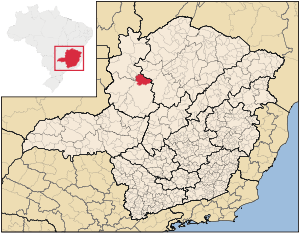
Brasilândia de Minas
Encyclopedia

Minas Gerais
Minas Gerais is one of the 26 states of Brazil, of which it is the second most populous, the third richest, and the fourth largest in area. Minas Gerais is the Brazilian state with the largest number of Presidents of Brazil, the current one, Dilma Rousseff, being one of them. The capital is the...
. As of 2007 the population was 12,821 in a total area of 2,515 km².
The elevation of the municipal seat is 530 meters above sea level. It became a municipality in 1997, separating from João Pinheiro
João Pinheiro, Minas Gerais
João Pinheiro is a municipality in the northwest of the Brazilian state of Minas Gerais. Its population in 2007 was 43,229 inhabitants in a total area of 10,717 km². It is the largest municipality in the state of Minas Gerais....
.
Geography
The climate is tropical with altitude characterized by a rainy season from October to April and a dry season from May to September. The vegetation is transitional between cerradoCerrado
The Cerrado, is a vast tropical savanna ecoregion of Brazil, particularly in the states of Gioas and Minas Gerais...
and caatinga
Caatinga
Caatinga is a type of vegetation, and an ecoregion characterized by this vegetation in the northeastern part of Brazil. The name "Caatinga" is a Tupi word meaning "white forest" or "white vegetation"...
. The maximum temperature is 38°C, the average is 23°C and the minimum is 15°C. Annual rainfall averages 1,400mm.
Brasilàndia de Minas belongs to the statistical micro-region of Paracatu
Paracatu, Minas Gerais
Paracatu is a town in the western part of the state of Minas Gerais, Brazil having 79,739 inhabitants . Its area is of 8.232 km²...
. This region has 10 municipalities and an area of 35,111.00 km². it lies just north of the Paracatu River
Paracatu River
The Paracatu River is located mainly in the state of Minas Gerais in Brazil. It is the longest tributary of the São Francisco, draining a basin of about 45,000 km², including 21 municipalities and the Federal District...
, a major tributary of the São Francisco River
São Francisco River
The São Francisco is a river in Brazil. With a length of , it is the longest river that runs entirely in Brazilian territory, and the fourth longest in South America and overall in Brazil...
, southeast of where it receives the Preto River. A paved road, MG-181, crosses the river and heads south to join the important national highway BR-040 near João Pinheiro. The distance to João Pinheiro is 84 km. Brasília is 300 km away while the state capital of Belo Horizonte is 496 km.
History
The first documents begin in the early nineteenth century telling of settlement in this region refer to lands belonging to Joaquina do Pompeu, whose complete name was Joaquina Maria Bernarda da Silva de Abreu Castello Branco Souto Maior de Oliveira Campos. With the death of this rich cattle baroness in 1824 lands were divided among heirs but a large area was acquired by an English company, Brazil Land Catte and Packing Company. These lands were abandoned during the second world war and later expropriated by President Getúlio VargasGetúlio Vargas
Getúlio Dornelles Vargas served as President of Brazil, first as dictator, from 1930 to 1945, and in a democratically elected term from 1951 until his suicide in 1954. Vargas led Brazil for 18 years, the most for any President, and second in Brazilian history to Emperor Pedro II...
. In 1952 a caravan of settlers arrived from Pirapora
Pirapora
Pirapora is a municipality in northcentral Minas Gerais in Brazil. Its population in 2007 was 51,636 in a total area of 577 km². The name Pirapora comes from the Tupi words for "fish" + "jump", referring to the piracema season when a mass migration of fishes ascends the São Francisco River...
and began to occupy the lands. The lands were divided into lots of 100 hectares that were given to the settlers along with 20 heifers, one bull, and some oxen. They had 20 years to pay it off, when they would receive the final deed of ownership.
By 1980 the population had reached 7,000 inhabitants. In 1991 the district of Brasilândia was created inside the municipality of João Pinheiro. In 1995 a vote was taken for emancipation and Yes got 3,305 votes and the No got 69 votes. In 1995 the municipality was created and in 1996 the first elections took place for mayor.
The economy
The main economic activities are cattle raising (50,340 head in 2006) and the cultivation of soybeans (2,800 ha.), corn (2,100 ha.), manioc, beans, and rice. There is also a small area of coffee. There wee 341 farms in 2006 with a total area of 141,357 ha. Of the total 15,000 hectares were planted in crops and the rest was natural pasture and forest land. Around 1,300 workers were involved in agriculture. There were 134 tractors.In the urban area there were 1,900 workers in industries (2005), 500 in commerce and 302 in public administration.
Health and education
In 2005 there were 4 health clinics, 3 public and 1 private. There were no hospitals and patients had to go to the nearest hospitals in Joºao Pinheiro or PiraporaPirapora
Pirapora is a municipality in northcentral Minas Gerais in Brazil. Its population in 2007 was 51,636 in a total area of 577 km². The name Pirapora comes from the Tupi words for "fish" + "jump", referring to the piracema season when a mass migration of fishes ascends the São Francisco River...
. In the school system there were 794 students enrolled in 2 primary schools and 247 students enrolled in 1 middle school.
Municipal Human Development Index
- MHDI: .745
- Ranking in the state: 326 out of 853 municipalities in 2000
- Ranking in the country: 2,020 out of 5,138 municipalities in 2000
- Life expectancy: 70 years
- Literacy rate: 84%

